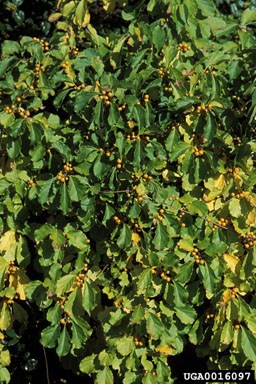
James H. Miller, USDA Forest Service, Bugwood.org Oriental bittersweet (Celastrus orbiculatus) is an attractive but very invasive deciduous, twining, and climbing woody vine to 60 feet with drooping branches in tree crowns, forming thicket and arbor infestations. It has alternate elliptic-to-rounded leaves 1.2-5 inches long. Female plants have axillary dangling clusters of inconspicuous yellowish flowers that yield spherical fruit capsules, green maturing to yellow, that split to reveal three-parted showy scarlet fleshy-covered seeds, which remain through winter at most leaf axils. Colonizes by prolific vine growth that root at nodes and seedlings from prolific seed spread mainly by birds, possibly by other animals and humans collecting and discarding decorative fruit-bearing vines. Seeds are highly viable, germinate even under dense shade, and after germination, grow rapidly when exposed to light. Most seed will germinate but only remain viable for one year in the soil. Resembles American bittersweet (C. scandens), which has only terminal white flower clusters that yield orange fruit capsules; leaves usually twice as large but absent among the flowers and fruit. Hybridization occurs between the two species. Management Strategies
|
Last updated: April 14, 2015
